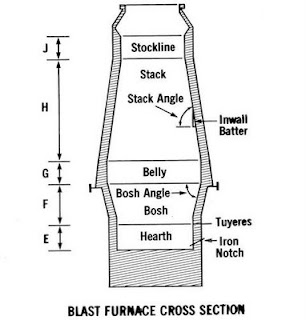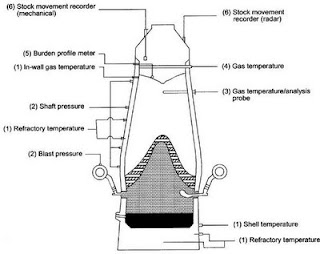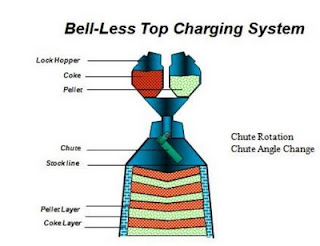19-July-2009
Blast Furnace Zones and Charging Systems





Amongst all the ironmaking processes, the Blast Furnace technology, which has been around the longest, still holds the dominant position. Many of the innovative ironmaking technologies that have emerged in the last few years will definitely complement the blast furnace in the coming years; but it is accepted even after these technologies are fully established, the blast furnace process will continue to be the principal ironmaking technology for iron makers. This is because though although the blast furnace process has a long history; it has remained up-to-date and competitive owing to the continuous and several innovative developments in its design and refractory lining pattern etc. that have taken place since its inception. The following table shows the history of Blast Furnace lining life:
Date
|
Daily production NTHM/day
|
Time before Reline/Repair in days(years)
|
Tons per lining NTHM
|
1600s
|
1
|
300 (0.8)
|
300
|
1700s
|
5
|
300 (0.8)
|
1500
|
1800s
|
30
|
300 (0.8)
|
9000
|
1910s
|
350
|
570 (1.5)
|
2,00000
|
1920s
|
500
|
1500 (4.1)
|
7,50,000
|
1940s
|
1600
|
1500 (4.1)
|
24,00000
|
1960s
|
2500
|
1500 (4.1)
|
37,50,000
|
1980s and 1990s
|
3600
|
2800 (7.7)
|
100,00000
|
During this period and till today, Iron & Steel industry and the Refractory industry have been working in tandem with each other to generate a win-win situation and ensure a steady growth for these industries. The equipment and systems of modern Blast Furnace Technology are designed for the harsh environment in the ironmaking operations, meeting the demands of reliable operation and minimal maintenance requirements. Hot metal production rates of 8000 - 10000 tpd, fuel rates of around 450 - 470 kg/thm (270/275 kg coke plus 175/225 kg coal), productivity of 2.5 - 3.0 t/m3/d (based on inner volume), and furnace availability ranging between 95 - 98% are the results of improved process control, better understanding of the process and stability of operations. Today the strategy of the iron-makers is to extend the campaign life of Blast Furnace as much as possible so that the total relining is required at least after 14 - 15 yrs of operation. However partial relining or repairing is required to enable safe operation side-by-side maintaining the quality of the product. To perform Blast Furnace rebuilds, relining and modernizations, extremely tight timeframes are demanded. This is achieved in close co-operation with local erection companies and means substantial cost benefits to the client. Moreover, for the last few years the trend is to replace smaller Blast Furnaces with large capacity Blast Furnaces, which are being subjected to stringent operating conditions like - high pressures at very high temperature of even more than 2000OC where sometimes the pressure goes beyond 5kg/cm2 on the Furnace Bottom. All these developments have ensured that the “Old” blast furnace remains “Young” and also the process of ironmaking in classical blast furnaces will continue to be the dominant method globally in the years ahead, as indeed has been the case in the past.
Related Articles
- Iron Making in Mini Blast Furnace (MBF)
- COREX® : An Innovative Ironmaking Metallurgical Process
- The FINEX® Process : The Latest Smelting Reduction (SR) Ironmaking Technology
- Blast Furnace - Refractory Lining Pattern
- Refractory Lining for Induction Furnace










.JPG)
.JPG)